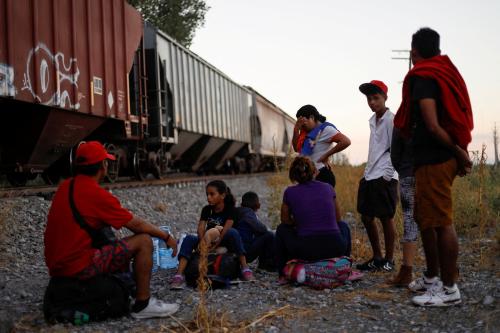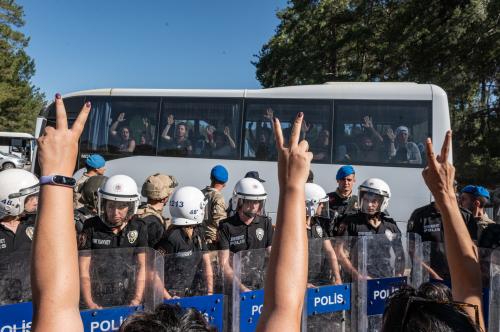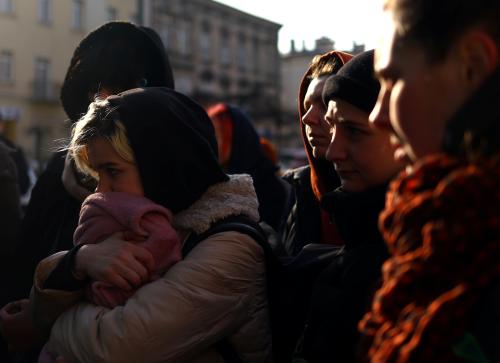At first glance, the return of hundreds of displaced Pashtun families from war-torn Kandahar province in southern Afghanistan to villages of origin in the comparatively peaceful north would seem an obvious and attractive option. It is a solution welcomed by a beleaguered Afghan government and supported by United Nations agencies conditioned to see return as the optimal, and perhaps only, durable solution for protracted IDP populations. But, as with many things in Afghanistan, appearances often deceive. According to the UN Refugee Agency, many IDPs themselves have recently asked for assistance to move from an IDP settlement near Kandahar to their former homes in the north. For IDPs caught in the midst of a worsening conflict in the south, one UN official likened decisions to return as perhaps the “least bad option”. However, latent tensions among various ethnic groups, limited central and local government authority, weak rule of law, and a striking lack of investment in development throughout the north undermine the sustainable return of displaced populations.
The historical experience of Pashtuns in the north is controversial and returning IDPs (and refugees) carry heavy baggage. Over a hundred years ago, Pashtuns began arriving in the north as part of a calculated state consolidation strategy by Abdur Rahman Khan, known as the “the Iron Amir,” to secure the northern areas of the country by settling fellow Pashtuns in contested, multi-ethnic regions.[1] A second wave of resettlement followed under Zahir Shah in the mid-twentieth century, as Pashtuns were again resettled as part of a continuing policy of Pashtunisation in the north, often on newly irrigated land and at the expense of the indigenous Turkmen, Uzbek and Tajik communities. These “immigrants” were called naqilin, to distinguish them from the original inhabitants of the area. These population relocations, several of them not fully voluntary[2], fostered lingering resentments among the new host population that persist today, particularly in areas where resource competition over land and water is highest.
Ethnic antipathy first erupted during the short-lived rule of the mujahideen following the fall of the Communist government. Many non-Pashtun communities (or specific commanders) took advantage of their strengthened position to take over land and property of Pashtun settlers. When the Taliban came to power in 1996, the Pashtun communities, now strengthened by a Pashtun-based government, retook what had been taken from them, at times occupying lands of non-Pashtuns. Following the fall of the Taliban in 2001, the tide again turned, and non-Pashtun communities took revenge, reclaiming their lands and attempted to push Pashtun communities out in a widespread series of village lootings in selected areas,[3] reprisal killings and kidnappings. Some of this retaliatory violence was supported by former mujahideen commanders linked to the Northern Alliance. Aside from scattered returns to certain areas, the majority of Pashtuns displaced by post-Taliban violence in the north have remained in camps in the south[4] or have begun to self-settle into Kandahar city. By UNHCR’s count, there are currently some 270,000 IDPs in Afghanistan, nearly half who had fled the north in lat 2001.[5]
During a recent visit to the northern province of Jawzjan for a research study, Brookings and The Liaison Office (TLO) located several of the IDP families who have returned in recent years to see how they had fared. Their stories were not encouraging. In one village—Eadhan Afghanai—some 150 families had been assisted over the last few years by UNHCR and the Ministry of Refugees and Repatriation to return, but only 30-40 remained amidst numerous abandoned houses.[6] Hassanabad, a stone’s throw from the provincial capital of Sheberghan, remains totally abandoned, despite the fact that approximately 20 IDP families have recently returned. These families claim to prefer the safety of Sheberghan’s main bazaar to the deep-seated antagonism of neighboring Arab villages back home, whose residents have claimed the surrounding farm and pastureland as their own.[7] In another village—Bashi Kot[8]—a village elder explained that the government-owned pastureland, which had previously been shared among ethnic groups, had been overtaken by neighboring non-Pashtun communities for cultivation, leaving little land for traditional animal grazing and agricultural production by Pashtun returnees.[9] He then showed us the only water point in the area: an ancient deep well that spewed boiling hot, salty water more than two hour’s walk from his village.[10] We were told it was unsafe to venture farther, as foreign Taliban were active in the area and our safety could not be guaranteed. Without exception, the villages we visited were empty of young men, who had returned south or even to Iran in search of work (a familiar story across Afghanistan). Among the elders we met, those who did not regret their decision to return were few and far between.
##1##This pattern—wherein IDPs are allowed to return, but local communities had used the power vacuum to redistribute land usage in their favor—recurred in all of the villages visited and was further confirmed by legal aid counselors addressing land and property issues. In the absence of central government authority and a strong rule of law, local legal aid counselors of the Norwegian Refugee Council admitted that disputes between returning IDPs and local residents tend to be settled in favor of the latter. These interventions, mostly through traditional jirgas rather than formal courts, have largely kept the peace but inhibited returning IDPs from successfully reestablishing themselves and reclaiming their land.[11] The altered political landscape in the north affects not just IDPs but refugees as well. Of the nearly 500,000 refugees originating from northern Afghanistan who are still in Pakistan, nearly seventy percent are Pashtuns, many of whom have cited landlessness and lack of shelter as reasons for their continued asylum.[12] Some return only to find themselves again displaced in IDP camps.
To some degree, these trends of political disequilibrium and subtle intimidation repeat themselves in provinces across the north: in Takhar, a group of 70 returning refugee families have remained huddled for nearly a year in a local bazaar, unable to access their traditional lands despite Central Government Decrees confirming their rights to the land.[13] In Balkh Province’s Sholgara region, over 150 returnee families remain powerless to reclaim lost lands from local inhabitants; in Faryab, a UNHCR Protection Officer was unable to find a single assisted-IDP return household, out of more than 60 assisted in 2008 by UNHCR, in villages of origin.[14] In January, the International Committee for the Red Cross assisted nearly 2,000 families displaced by fighting between ethnic Tajiks and Pashtuns in Badghis Province alone.[15]
A former UN staff member noted that many of the IDPs still in the south had never been well-integrated with local communities to begin with, having been settled on land that could not sustain them in the long-term, which only created competition with neighboring non-Pashtun communities over scarce resources. In areas of more abundant natural resources, the integration of Pashtuns in the local social landscape was smoother without resource competition arising.[16]
A series of interviews conducted with IDPs in Zhari Dasht Camp by The Liaison Office suggest that, by and large, people continue to fear for their safety if they return and that the underlying causes of flight have not yet been adequately addressed. In some cases, those who had previously supported the Taliban felt they might still be targets of reprisal violence if they went back. Others reported that their land had been seized by local residents. Several of those interviewed mentioned neighboring families who had attempted to return to their villages, but returned to the camp as a result of harassment or lack of livelihood prospects in the north.[17] As one jobless IDP returnee in Jawzjan noted, “Uzbeks only hire Uzbeks, Pashtuns only hire Pashtuns.” And, as most land currently is occupied by non-Pashtun communities, even daily labor or sharecropping is no longer an option for returning IDPs.
In parts of Faryab and Badghis provinces, where insurgent activity and subsequent population displacement is on the rise, returning IDPs could find themselves again caught in a cycle of violence, with collaboration or collusion with insurgents their only means of sustaining themselves in villages of origin. There is precedent for this in Jawzjan. In the Dashti Lali area, disaffection with the current provincial administration, which is increasingly seen to overtly favor non-Pashtun communities, is fueling a reconsideration of local political allegiances. According to one elder, “if you are caught in the middle, you have to join a side.”[18] Disgruntled or economically-vulnerable IDP communities, therefore, may well become the next recruitment market for a growing insurgency in the north and west of the country.
With “hearts and minds” taken for granted, comparatively little development assistance has been invested in the northern region. Development funds have instead been closely tied to military and political objectives and spent disproportionately in areas affected by the insurgency (or in urban areas, predominantly Kabul). Whereas violence-plagued provinces of Uruzgan and Kandahar receive approximately $150 per capita in development assistance, many of the provinces in the north receive less than $30.[19] The thousands of flood victims currently camped under plastic sheets in Balkh and along the western highway out of Mazar-i-Sharif—the same multitudes displaced last year by severe drought—are a powerful testament to the lack of planning for and investment in sustainable development across the northern region.
All of this matters for several reasons: First, the plight of IDPs is undoubtedly worsening amid increasing insecurity in the south—local residents and IDPs alike are caught in the crosshairs of the conflict between pro-government forces and insurgents. All assistance to the primary IDP camp, Zhari Dasht, was cut-off in 2006 to encourage IDPs to return, although fewer than a quarter of the nearly 40,000 original residents[20] chose to do so, citing security concerns and lack of livelihood prospects in the north. More recently, other limitations on freedom of movement impede the ability of IDPs to move back and forth between the Zhari Dasht camp and Kandahar-city to find daily labor, creating yet another push factor. While most observers expect the conflict to worsen in areas around the camp in the coming year, there is still a pronounced reluctance to return among IDPs, who understand that further friction and hardship await them in villages of origin.
Evidence suggests that those who opt to return soon find themselves again displaced, this time as economic migrants who are more easily dismissed by provincial authorities and largely ignored by relief agencies. Many with whom we spoke would have preferred local integration or resettlement if offered.[21] One elder exclaimed, “If we had had another option, we would have stayed. If we had not been promised more than we received, we would not have returned”.[22]
For humanitarian agencies tied in knots by insecurity and a subsequent lack of access and options, the opportunity to assist IDPs to finally head home seems too good to pass up. However, in the absence of meaningful reconciliation and tangible, equitably-distributed development initiatives, return is likely to be a pyrrhic victory, prompting new waves of displacement and family separation. Furthermore, by attempting to recreate conditions that have been the source of much discord and tension in the past (and reinforce past controversial population relocation policies), the humanitarian community may, however inadvertently, sow the seeds of future ethnic conflict in the north and prompt further internal displacement.
For a national government with little practical authority outside Kabul and long conditioned to see IDPs as either short-term or economically-motivated, and return as the most preferred (if not only) solution, it is time to look for other more realistic protection-oriented alternatives. The Guiding Principles on Internal Displacement, among other things, advocate for the government to ensure that the choices of IDPs regarding their choice of durable solutions—return, local integration or resettlement in another part of the country—are respected and carried out in conditions of safety and dignity.
It’s time to restart a conversation with IDPs and provide them with realistic alternatives to return. Until then, IDPs will continue to find themselves stuck between a rock and a hard place in Afghanistan.
[1] Louis Dupree (1980) Afghanistan, (Princeton: Princeton University Press)., Nancy Tapper (1983), ‘Abd al-Rahman’s North-West Frontier: The Pashtun Colonisation of Afghan Turkistan’, in Richard Tapper (ed.), The Conflict of Tribe and State in Iran and Afghanistan (London: Croom Helm) pp.233-261.
[2] Albeit relocated populations were compensated for their move by receiving land. Many had previously been landless Kuchi (Afghan Nomad) populations.
[3] Note: not all Pashtun areas were equally effected by violence. In some cases, Pashtun communities were well integrated.
[4] The official one in Zhari Dasht, and several in-official ones in Spin Boldak. Some refugees also fled to closer areas, such as Mazar-i-Sharif
[5] “National IDP Profile” Afghanistan National IDP Task Force. December 2008. (updated figures provided at IDP TF meeting, 12 May 2009. The National Profiling estimates that 166,000 were displaced as a result of fighting associated with the fall of the Taliban, primarily in the north.
[6] Interview with UNHCR Senior Field Assistant, May 2008
[7] TLO/BB interview with village elder and visit to Hassanabad. 20 May 2009
[8] In the Dashti Lali region where a famous struggle between a mujahideen commander and the Taliban had occurred.
[9] About 45 percent of the total land area in Afghanistan is pastureland designated to support livestock of settled and non-settled populations. It is for this land, however, that “land tenure arrangements are least well developed … and most subject to contention and even armed conflict” (Wily, Liz Alden (2003) Land Rights in Crisis: Restoring Tenure Insecurity in Afghanistan, Issues Paper Series; Kabul: Afghanistan Research and Evaluation Unit (AREU), March 2003.
[10] Early assessments by UNAMA with an international NGO had already shown that most water in this region was linked to salty hot springs; hence while there was a lot of land, water would always be a problem. Already then, in 2002, it was clear that sustainability of return could be a problem. Interview, ex-UNAMA official, Kabul, 22 May 2009
[11] interview with Norwegian Refugee Council ILAC legal aid counselors, Mazar-i-Sharif, 21 May.
[12] UNHCR Official Refugee Statistics, 2009
[13] Brookings-Bern visit to Khoja Bhaludin, Takhar, November 2008.
[14] Interviews with UNHCR Protection Officer, Mazar-i-Sharif, 23 May 2009 and UNAMA Assistant Political Affairs Officer, Mazar-i-Sharif; 21 May 2009
[15] interview with ICRC Economic Security Officer, 25 May 2008
[16] Interview with former UNAMA official, Kabul, 23 May 2009.
[17] semi-structured interviews in Zhari Dasht Camp. April 2009.
[18] Village elder, Bashi Kot village, Dashit Lali area, Jawzjan, 20 May 2009
[19] “Falling Short: Aid Effectiveness in Afghanistan.” Acbar. March 2008
[20] National Profile of IDPs in Afghanistan. IDP Task Force. December 2008
[21] The Liaison Office/Brooking-Bern Project, study on Displacement in Kandahar. Interviews conducted with IDPs in several locations in Kandahar in April 2008 and with returnees in Bashi Kot, Hassanabad, and Tarnaw villages in Jawzjan, May 2008.
[22] Village elder, Tarnaw village, Jawzjan, 20 May 209



Commentary
Op-edBetween a Rock and a Hard Place: The Return of Internally Displaced Persons to Northern Afghanistan
June 1, 2009